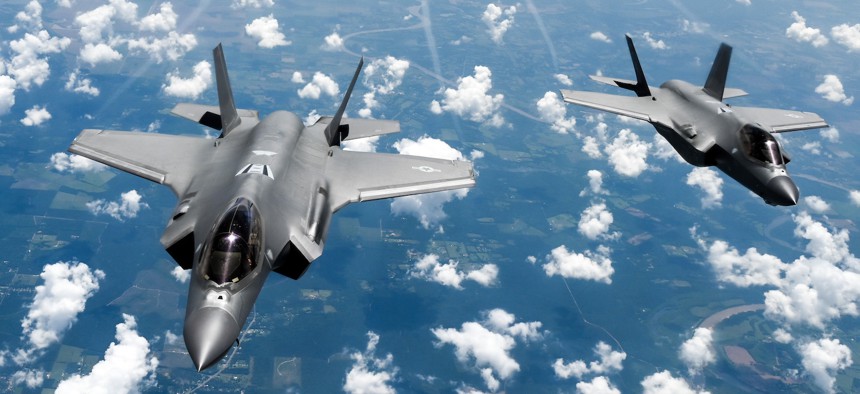
The F-35 Lightning II Demonstration Team assigned to 388th Fighter Wing at Hill Air Force Base, Utah, heads back to home station after receiving aerial refueling from a KC-135 Stratotanker assigned to the 465th Air Refueling Squadron at Tinker Air Force Base, Oklahoma, May 31, 2023. U.S. Air Force / 2nd Lt. Mary Begy
Senate Lawmakers Want to Ax Alternate F-35 Engine Program
SASC markup on collision course with House over funding new engine technology.
Senate authorizers do not want a new engine for the F-35—despite House lawmakers arguing that funding an alternative engine program is needed to keep next-gen engine technology for future fighter aircraft on track.
Senate Armed Services Committee chairman Sen. Jack Reed’s markup of the annual defense policy bill does not fund the Adaptive Engine Transition Program, or AETP, committee staff told reporters Friday. The adaptive engine program seeks to develop a powerful, but fuel-efficient engine for future warplanes.
Asked about the rationale behind the decision, committee staff simply said “members didn’t want to fund it.” This is in line with the Air Force’s proposal to end funding for the adaptive engine in its fiscal 2024 budget and press on with Pratt & Whitney’s proposed upgrade to the F-35’s current engine. Service officials said the adaptive engine is too expensive to ever make it into the fighter.
While there was no specific decision on which engine Senate authorizers want in the F-35, there was also “no movement to change the president's budget, so by default they're OK with it for the moment,” one staffer said.
However, both House committees want to keep the program alive, with authorizers requesting over half a billion dollars and appropriators requesting $150 million.
This move comes amid a public spat over the engine program. Pratt executives accused a Lockheed executive of making misleading statements about the F-35’s need for a new engine years from now. After Lockheed issued public support for the adaptive engine, Pratt accused Lockheed of trying to market the F-35 as a sixth-generation fighter jet.
While Pratt and GE both have teams working on adaptive engine proposals, Pratt stands to benefit if Congress keeps the Air Force plans for its engine upgrade, instead of putting a new engine into the F-35. Reed’s markup would keep funding Pratt’s engine upgrade at the president’s request—at $245 million in 2024 for the Air Force, a Senate staffer said.
A final decision on the adaptive engine program won’t come until the Senate and House pass their versions of the annual defense policy bill and it is reconciled in a committee with both branches.
Senate authorizers also want to greenlight the Air Force’s plan to get rid of some of its old aircraft, such as A-10 Warthogs and F-15C and -D fighters, and put the savings toward future fighter aircraft, in line with House authorizers’ markup.
Both Senate and House markups would block the service’s proposal to shed 32 Block 20 F-22s, making it the second straight year Congress has denied the request. The mark keeps the current requirement in place that the Air Force needs to keep all F-22s until 2027, a Senate staffer said.
The Air Force wants to get rid of its older F-22s because it would require too much effort and cost too much to get them ready for battle, service officials have said.




